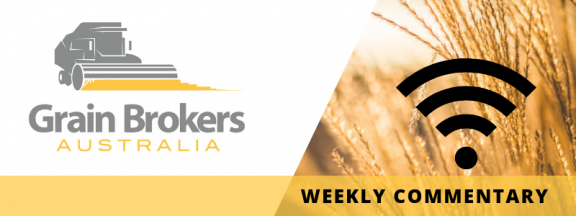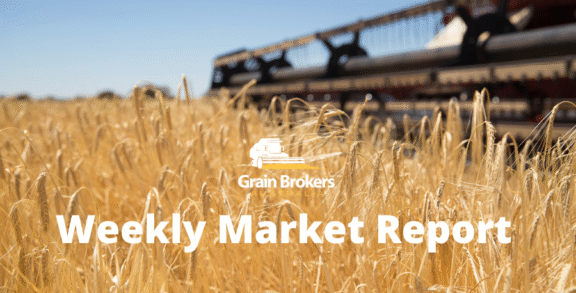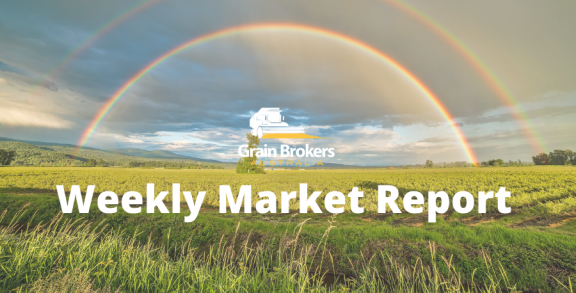
Global supply issues likely to push wheat values higher …
by Peter McMeekin – 9th October, 2018
The month of October heralds the start of a new grain marketing year here in Australia. The first week of the 2018/19 season has been highlighted by significant, but not drought-breaking, rainfall through parts of Queensland, New South Wales and Western Australia.
The falls in New South Wales were generally highest in the western pastoral zones (ideal for spring pasture growth), or in the northwestern cropping areas that either didn’t plant or have long been written off due to drought. There were some patchy falls east of the Newell Highway and they will stabilise production in those paddocks that have not already been cut for hay or been grazed off by hungry livestock.
Some of the most beneficial precipitation over the past week fell on the Darling Downs where some districts recorded up to 50mm. The deep, rich fertile soils have been starved of moisture for most of the year. It would normally be a sea of green at this time of the year as winter crops mature and new crop sorghum emerges. Some growers will manage to harvest some winter crop but most of the region has been in an enforced fallow period and will take at least 100mm to build an adequate moisture profile for a widescale summer crop plant.
In Western Australia, an extremely dry September and several severe frosts early in the month, had put downward pressure on potential record-breaking winter crop production estimates. Although patchy in some districts, the falls were very welcome and will certainly help to consolidate grain production across most of the state’s cropping zones.
The wet weather basically deserted Victoria and South Australia. Production forecasts are falling by the day in both states. As production certainty evaporates the drought-driven hay price is providing many growers with potential returns far greater than they could possibly hope for by taking the crop through to harvest.
Depending on quality, cereal hay is currently bringing up to $600 per tonne in southern Queensland and northern New South Wales, up to $550/tonne in central New South Wales, more than $500/tonne in Gippsland and around $400/tonne in the Goulburn Valley.
The burning question here is “Are these prices sustainable?”
As more and more crops are cut and baled, supply will increase. High prices such as these will also ration demand as it will simply be too expensive for many to continue feeding livestock. And the drought-breaking rains are a day closer. For those cutting and baling winter crop with the intention of selling, it is critical to lock in the good margins currently available before the market falls.
As the drought intensifies on the east coast, domestic grain demand has slowed exports dramatically. Australian consumers are buying wheat and barley away from traditional Asian export customers in order to meet their domestic requirements.
According to the Australia Bureau of Statistics (ABS), Australian wheat exports for the month of August were 760 thousand metric tonne (KMT), down from 1.35 million metric tonne (MMT). This puts exports to the end of August at 12.85MMT. With only the September data required to finalise the 2017/18 figures, it seems highly unlikely that they will surpass 14MMT for the full marketing year.
Barley exports for August were a paltry 245KMT, similar to the July number of 255KMT. Exports to the end of August for the 2017/18 season totalled 6MMT, with 37 per cent (2.2MMT) shipped as malting barley and 63 per cent (3.8MMT) shipped as feed barley.
Rising wheat futures and the result of last week’s Egyptian (GASC) tender both suggest that global wheat prices are trending higher. GASC confirmed 180KMT of purchases for early December arrival, all Russian origin and US$8 higher than the mid-September tender.
More than 650kmt was offered by Russian exporters in the early December delivery window, despite the latest threat (then denial) to halt or slow operations at a number of elevators in Krasnodar and Rostov due to phytosanitary issues. Romanian offers were US$6 higher than GASC purchases and French values were US$25 off the pace.
The most recent United States wheat export figures were as expected but did include sales to both Saudi Arabia and Brazil. The Black Sea is still the cheapest export origin, but lower supply, possible shipping restrictions, and the onset of winter will slow the export pace and the US is poised to seize the opportunity when it surfaces.
Elsewhere, Iraq bought Canadian wheat in a private tender and then announced that water shortages would reduce their planted area by 55 per cent, to 315 thousand hectares, all irrigated. This will mean increased imports in the coming year. In Canada, the harvest continues to be interrupted by snowfalls, with the latest Saskatchewan update putting the harvest at just 58 per cent complete, compared to 92 per cent at the same time last year.
As the Australian harvest picks up pace there are many loose ends in the global wheat balance sheet. The United States Department of Agriculture (USDA) will release their latest World Agricultural Supply and Demand Estimates (WADSE) on Thursday night (Aussie time), and there should be some significant changes.
Global supply issues are likely to continue, adding impetus to the recent upward price trend.
Peter McMeekin is a consultant to Grain Brokers Australia. Call 1300 946 544 to discuss your grain marketing needs.





